brakes NISSAN MICRA 2016 Owner´s Manual
[x] Cancel search | Manufacturer: NISSAN, Model Year: 2016, Model line: MICRA, Model: NISSAN MICRA 2016Pages: 299, PDF Size: 3.54 MB
Page 88 of 299
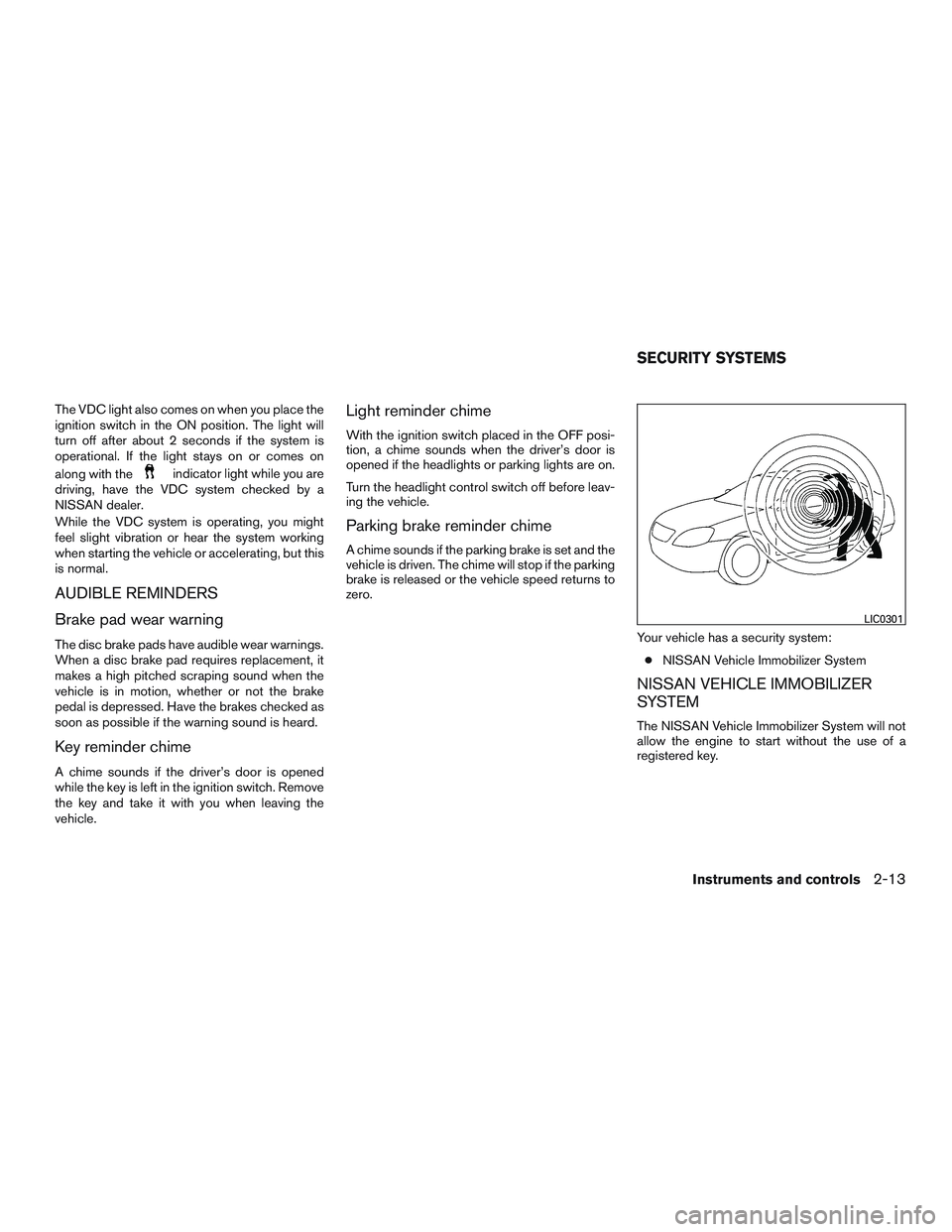
The VDC light also comes on when you place the
ignition switch in the ON position. The light will
turn off after about 2 seconds if the system is
operational. If the light stays on or comes on
along with the
indicator light while you are
driving, have the VDC system checked by a
NISSAN dealer.
While the VDC system is operating, you might
feel slight vibration or hear the system working
when starting the vehicle or accelerating, but this
is normal.
AUDIBLE REMINDERS
Brake pad wear warning
The disc brake pads have audible wear warnings.
When a disc brake pad requires replacement, it
makes a high pitched scraping sound when the
vehicle is in motion, whether or not the brake
pedal is depressed. Have the brakes checked as
soon as possible if the warning sound is heard.
Key reminder chime
A chime sounds if the driver’s door is opened
while the key is left in the ignition switch. Remove
the key and take it with you when leaving the
vehicle.
Light reminder chime
With the ignition switch placed in the OFF posi-
tion, a chime sounds when the driver’s door is
opened if the headlights or parking lights are on.
Turn the headlight control switch off before leav-
ing the vehicle.
Parking brake reminder chime
A chime sounds if the parking brake is set and the
vehicle is driven. The chime will stop if the parking
brake is released or the vehicle speed returns to
zero.
Your vehicle has a security system:● NISSAN Vehicle Immobilizer System
NISSAN VEHICLE IMMOBILIZER
SYSTEM
The NISSAN Vehicle Immobilizer System will not
allow the engine to start without the use of a
registered key.
LIC0301
SECURITY SYSTEMS
Instruments and controls2-13
Page 182 of 299
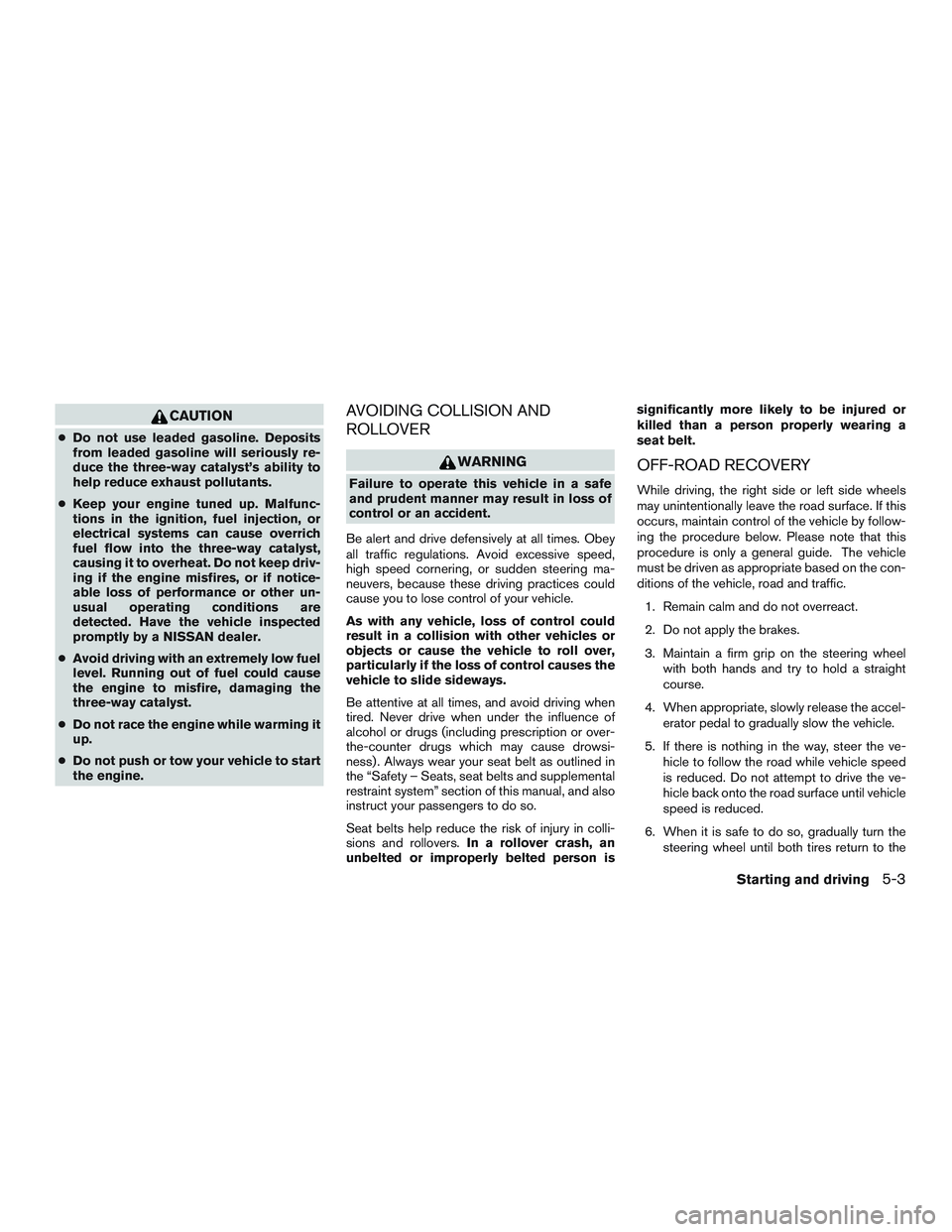
CAUTION
●Do not use leaded gasoline. Deposits
from leaded gasoline will seriously re-
duce the three-way catalyst’s ability to
help reduce exhaust pollutants.
● Keep your engine tuned up. Malfunc-
tions in the ignition, fuel injection, or
electrical systems can cause overrich
fuel flow into the three-way catalyst,
causing it to overheat. Do not keep driv-
ing if the engine misfires, or if notice-
able loss of performance or other un-
usual operating conditions are
detected. Have the vehicle inspected
promptly by a NISSAN dealer.
● Avoid driving with an extremely low fuel
level. Running out of fuel could cause
the engine to misfire, damaging the
three-way catalyst.
● Do not race the engine while warming it
up.
● Do not push or tow your vehicle to start
the engine.
AVOIDING COLLISION AND
ROLLOVER
WARNING
Failure to operate this vehicle in a safe
and prudent manner may result in loss of
control or an accident.
Be alert and drive defensively at all times. Obey
all traffic regulations. Avoid excessive speed,
high speed cornering, or sudden steering ma-
neuvers, because these driving practices could
cause you to lose control of your vehicle.
As with any vehicle, loss of control could
result in a collision with other vehicles or
objects or cause the vehicle to roll over,
particularly if the loss of control causes the
vehicle to slide sideways.
Be attentive at all times, and avoid driving when
tired. Never drive when under the influence of
alcohol or drugs (including prescription or over-
the-counter drugs which may cause drowsi-
ness) . Always wear your seat belt as outlined in
the “Safety – Seats, seat belts and supplemental
restraint system” section of this manual, and also
instruct your passengers to do so.
Seat belts help reduce the risk of injury in colli-
sions and rollovers. In a rollover crash, an
unbelted or improperly belted person is significantly more likely to be injured or
killed than a person properly wearing a
seat belt.
OFF-ROAD RECOVERY
While driving, the right side or left side wheels
may unintentionally leave the road surface. If this
occurs, maintain control of the vehicle by follow-
ing the procedure below. Please note that this
procedure is only a general guide. The vehicle
must be driven as appropriate based on the con-
ditions of the vehicle, road and traffic.
1. Remain calm and do not overreact.
2. Do not apply the brakes.
3. Maintain a firm grip on the steering wheel with both hands and try to hold a straight
course.
4. When appropriate, slowly release the accel- erator pedal to gradually slow the vehicle.
5. If there is nothing in the way, steer the ve- hicle to follow the road while vehicle speed
is reduced. Do not attempt to drive the ve-
hicle back onto the road surface until vehicle
speed is reduced.
6. When it is safe to do so, gradually turn the steering wheel until both tires return to the
Starting and driving5-3
Page 183 of 299
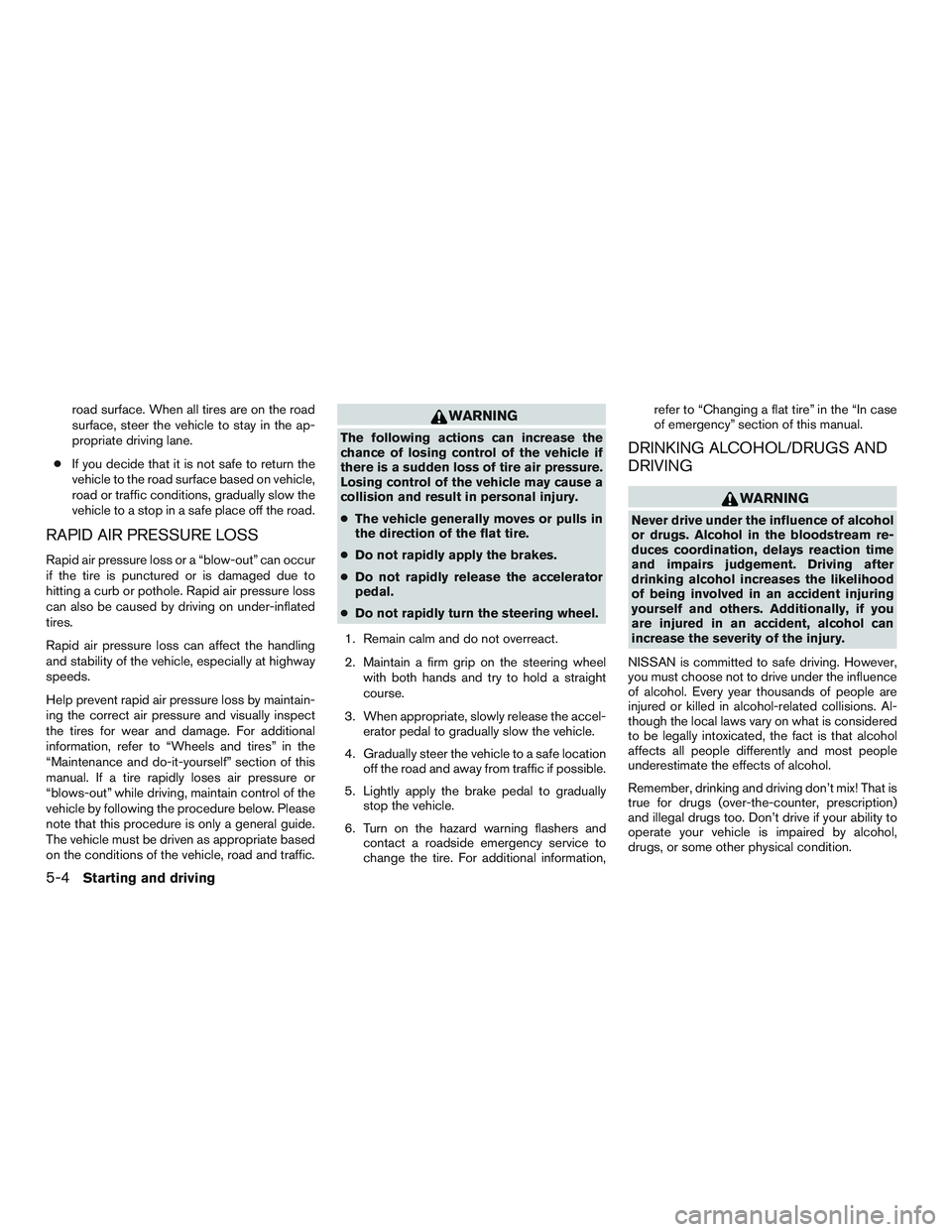
road surface. When all tires are on the road
surface, steer the vehicle to stay in the ap-
propriate driving lane.
● If you decide that it is not safe to return the
vehicle to the road surface based on vehicle,
road or traffic conditions, gradually slow the
vehicle to a stop in a safe place off the road.
RAPID AIR PRESSURE LOSS
Rapid air pressure loss or a “blow-out” can occur
if the tire is punctured or is damaged due to
hitting a curb or pothole. Rapid air pressure loss
can also be caused by driving on under-inflated
tires.
Rapid air pressure loss can affect the handling
and stability of the vehicle, especially at highway
speeds.
Help prevent rapid air pressure loss by maintain-
ing the correct air pressure and visually inspect
the tires for wear and damage. For additional
information, refer to “Wheels and tires” in the
“Maintenance and do-it-yourself” section of this
manual. If a tire rapidly loses air pressure or
“blows-out” while driving, maintain control of the
vehicle by following the procedure below. Please
note that this procedure is only a general guide.
The vehicle must be driven as appropriate based
on the conditions of the vehicle, road and traffic.
WARNING
The following actions can increase the
chance of losing control of the vehicle if
there is a sudden loss of tire air pressure.
Losing control of the vehicle may cause a
collision and result in personal injury.
● The vehicle generally moves or pulls in
the direction of the flat tire.
● Do not rapidly apply the brakes.
● Do not rapidly release the accelerator
pedal.
● Do not rapidly turn the steering wheel.
1. Remain calm and do not overreact.
2. Maintain a firm grip on the steering wheel with both hands and try to hold a straight
course.
3. When appropriate, slowly release the accel- erator pedal to gradually slow the vehicle.
4. Gradually steer the vehicle to a safe location off the road and away from traffic if possible.
5. Lightly apply the brake pedal to gradually stop the vehicle.
6. Turn on the hazard warning flashers and contact a roadside emergency service to
change the tire. For additional information, refer to “Changing a flat tire” in the “In case
of emergency” section of this manual.DRINKING ALCOHOL/DRUGS AND
DRIVING
WARNING
Never drive under the influence of alcohol
or drugs. Alcohol in the bloodstream re-
duces coordination, delays reaction time
and impairs judgement. Driving after
drinking alcohol increases the likelihood
of being involved in an accident injuring
yourself and others. Additionally, if you
are injured in an accident, alcohol can
increase the severity of the injury.
NISSAN is committed to safe driving. However,
you must choose not to drive under the influence
of alcohol. Every year thousands of people are
injured or killed in alcohol-related collisions. Al-
though the local laws vary on what is considered
to be legally intoxicated, the fact is that alcohol
affects all people differently and most people
underestimate the effects of alcohol.
Remember, drinking and driving don’t mix! That is
true for drugs (over-the-counter, prescription)
and illegal drugs too. Don’t drive if your ability to
operate your vehicle is impaired by alcohol,
drugs, or some other physical condition.
5-4Starting and driving
Page 200 of 299
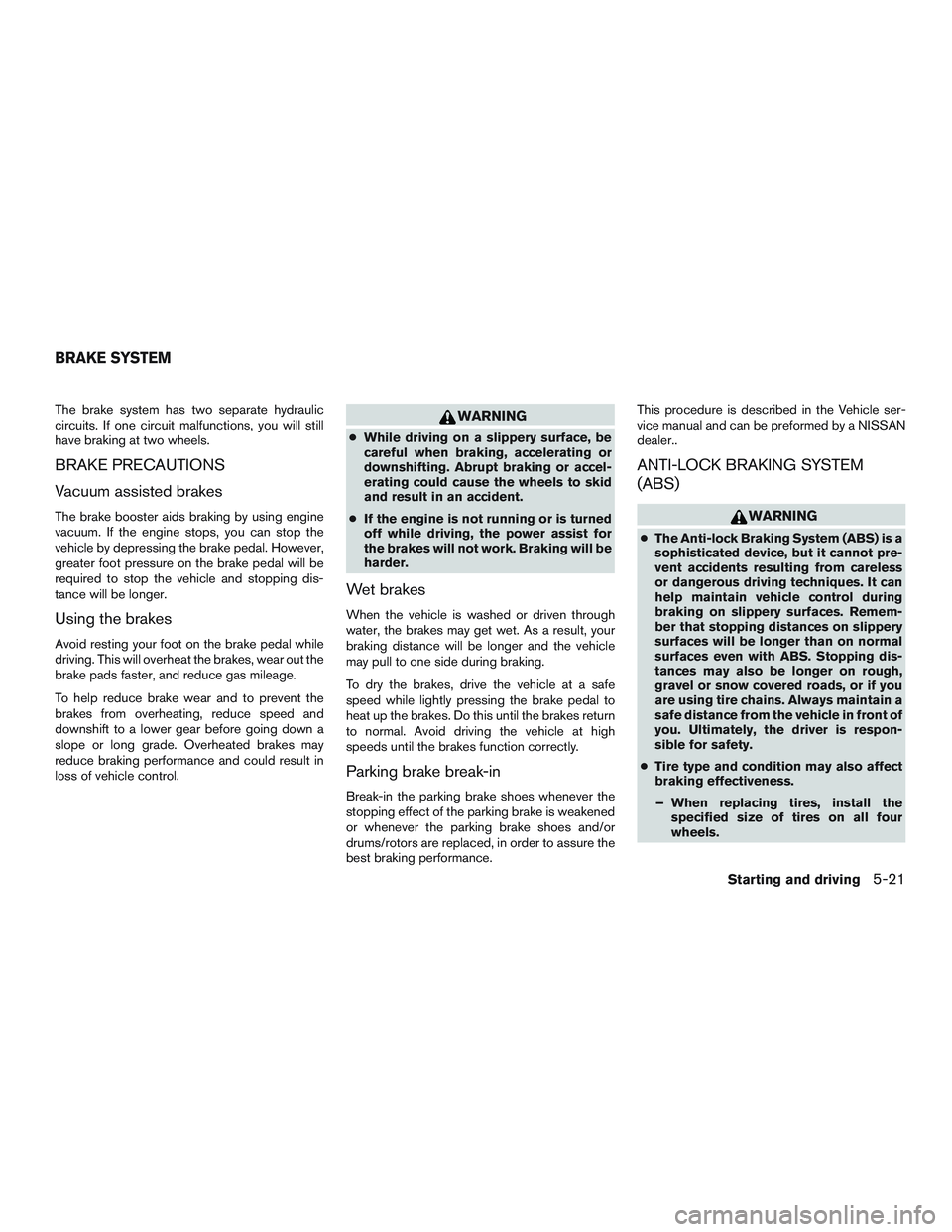
The brake system has two separate hydraulic
circuits. If one circuit malfunctions, you will still
have braking at two wheels.
BRAKE PRECAUTIONS
Vacuum assisted brakes
The brake booster aids braking by using engine
vacuum. If the engine stops, you can stop the
vehicle by depressing the brake pedal. However,
greater foot pressure on the brake pedal will be
required to stop the vehicle and stopping dis-
tance will be longer.
Using the brakes
Avoid resting your foot on the brake pedal while
driving. This will overheat the brakes, wear out the
brake pads faster, and reduce gas mileage.
To help reduce brake wear and to prevent the
brakes from overheating, reduce speed and
downshift to a lower gear before going down a
slope or long grade. Overheated brakes may
reduce braking performance and could result in
loss of vehicle control.
WARNING
●While driving on a slippery surface, be
careful when braking, accelerating or
downshifting. Abrupt braking or accel-
erating could cause the wheels to skid
and result in an accident.
● If the engine is not running or is turned
off while driving, the power assist for
the brakes will not work. Braking will be
harder.
Wet brakes
When the vehicle is washed or driven through
water, the brakes may get wet. As a result, your
braking distance will be longer and the vehicle
may pull to one side during braking.
To dry the brakes, drive the vehicle at a safe
speed while lightly pressing the brake pedal to
heat up the brakes. Do this until the brakes return
to normal. Avoid driving the vehicle at high
speeds until the brakes function correctly.
Parking brake break-in
Break-in the parking brake shoes whenever the
stopping effect of the parking brake is weakened
or whenever the parking brake shoes and/or
drums/rotors are replaced, in order to assure the
best braking performance. This procedure is described in the Vehicle ser-
vice manual and can be preformed by a NISSAN
dealer..
ANTI-LOCK BRAKING SYSTEM
(ABS)
WARNING
●
The Anti-lock Braking System (ABS) is a
sophisticated device, but it cannot pre-
vent accidents resulting from careless
or dangerous driving techniques. It can
help maintain vehicle control during
braking on slippery surfaces. Remem-
ber that stopping distances on slippery
surfaces will be longer than on normal
surfaces even with ABS. Stopping dis-
tances may also be longer on rough,
gravel or snow covered roads, or if you
are using tire chains. Always maintain a
safe distance from the vehicle in front of
you. Ultimately, the driver is respon-
sible for safety.
● Tire type and condition may also affect
braking effectiveness.
– When replacing tires, install the specified size of tires on all four
wheels.
BRAKE SYSTEM
Starting and driving5-21
Page 201 of 299
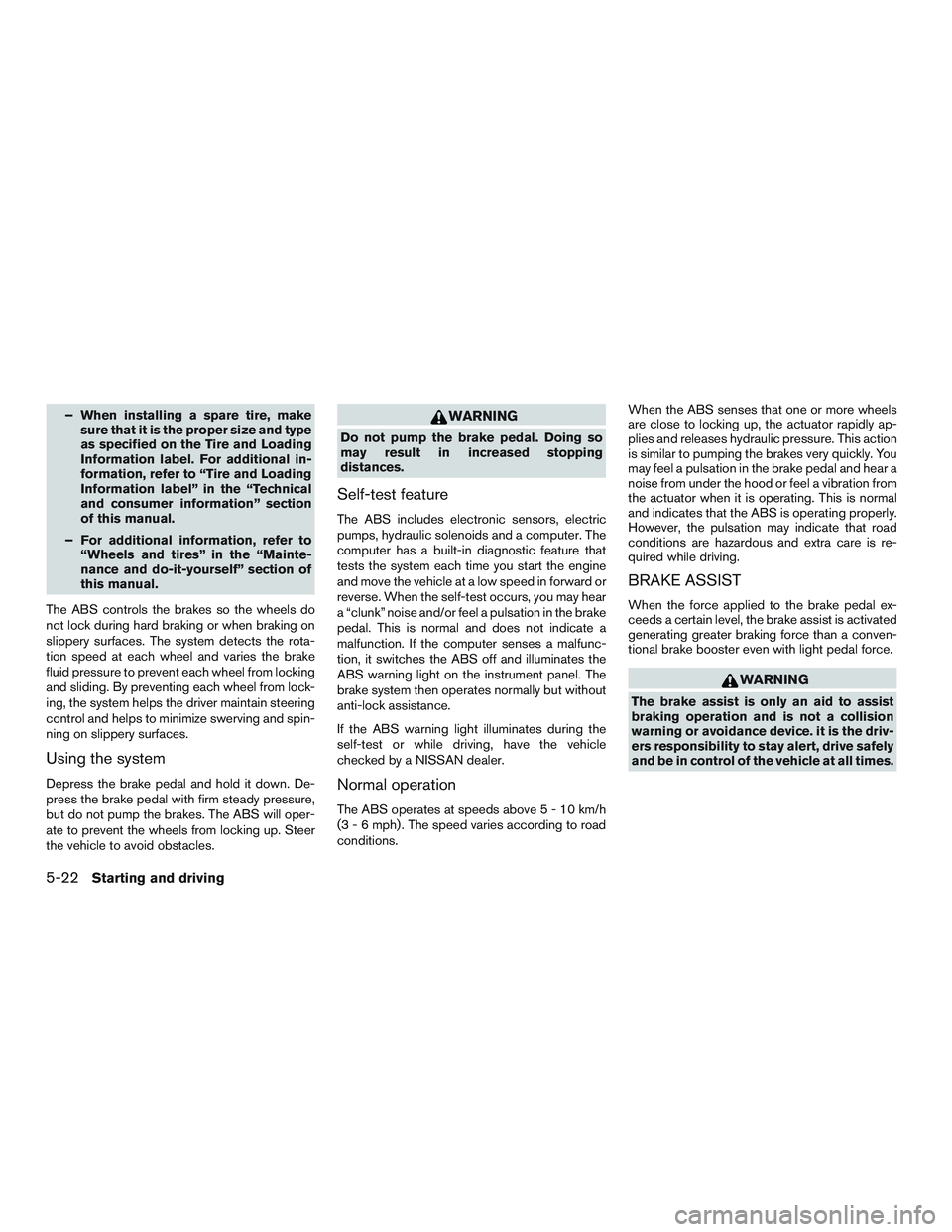
– When installing a spare tire, makesure that it is the proper size and type
as specified on the Tire and Loading
Information label. For additional in-
formation, refer to “Tire and Loading
Information label” in the “Technical
and consumer information” section
of this manual.
– For additional information, refer to “Wheels and tires” in the “Mainte-
nance and do-it-yourself” section of
this manual.
The ABS controls the brakes so the wheels do
not lock during hard braking or when braking on
slippery surfaces. The system detects the rota-
tion speed at each wheel and varies the brake
fluid pressure to prevent each wheel from locking
and sliding. By preventing each wheel from lock-
ing, the system helps the driver maintain steering
control and helps to minimize swerving and spin-
ning on slippery surfaces.
Using the system
Depress the brake pedal and hold it down. De-
press the brake pedal with firm steady pressure,
but do not pump the brakes. The ABS will oper-
ate to prevent the wheels from locking up. Steer
the vehicle to avoid obstacles.
WARNING
Do not pump the brake pedal. Doing so
may result in increased stopping
distances.
Self-test feature
The ABS includes electronic sensors, electric
pumps, hydraulic solenoids and a computer. The
computer has a built-in diagnostic feature that
tests the system each time you start the engine
and move the vehicle at a low speed in forward or
reverse. When the self-test occurs, you may hear
a “clunk” noise and/or feel a pulsation in the brake
pedal. This is normal and does not indicate a
malfunction. If the computer senses a malfunc-
tion, it switches the ABS off and illuminates the
ABS warning light on the instrument panel. The
brake system then operates normally but without
anti-lock assistance.
If the ABS warning light illuminates during the
self-test or while driving, have the vehicle
checked by a NISSAN dealer.
Normal operation
The ABS operates at speeds above5-10km/h
(3 - 6 mph) . The speed varies according to road
conditions. When the ABS senses that one or more wheels
are close to locking up, the actuator rapidly ap-
plies and releases hydraulic pressure. This action
is similar to pumping the brakes very quickly. You
may feel a pulsation in the brake pedal and hear a
noise from under the hood or feel a vibration from
the actuator when it is operating. This is normal
and indicates that the ABS is operating properly.
However, the pulsation may indicate that road
conditions are hazardous and extra care is re-
quired while driving.
BRAKE ASSIST
When the force applied to the brake pedal ex-
ceeds a certain level, the brake assist is activated
generating greater braking force than a conven-
tional brake booster even with light pedal force.
WARNING
The brake assist is only an aid to assist
braking operation and is not a collision
warning or avoidance device. it is the driv-
ers responsibility to stay alert, drive safely
and be in control of the vehicle at all times.
5-22Starting and driving
Page 230 of 299
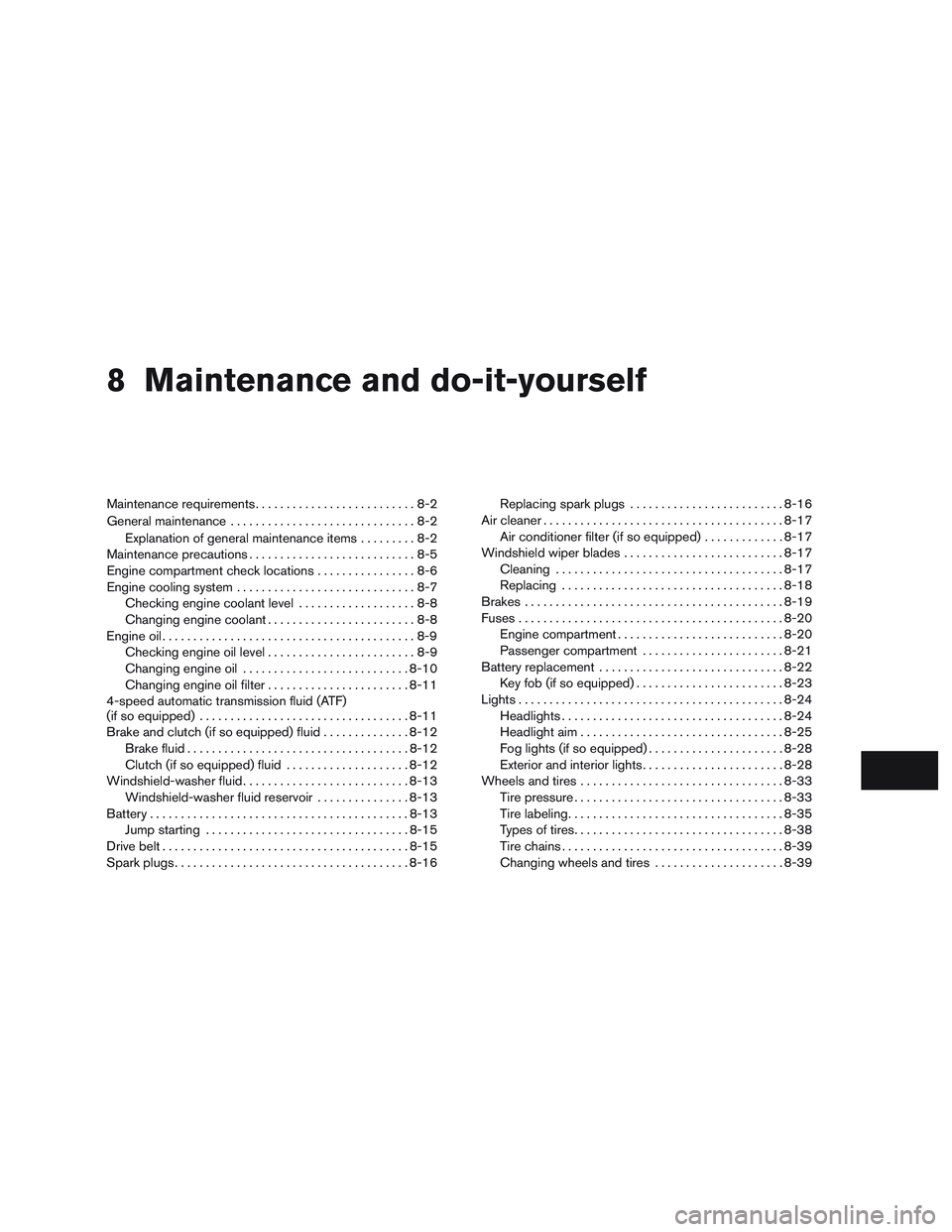
8 Maintenance and do-it-yourself
Maintenance requirements..........................8-2
General maintenance ..............................8-2
Explanation of general maintenance items .........8-2
Maintenance precautions ...........................8-5
Engine compartment check locations ................8-6
Engine cooling system .............................8-7
Checking engine coolant level ...................8-8
Changing engine coolant ........................8-8
Engine oil .........................................8-9
Checking engine oil level ........................8-9
Changing engine oil ........................... 8-10
Changing engine oil filter .......................8-11
4-speed automatic transmission fluid (ATF)
(if so equipped) .................................. 8-11
Brake and clutch (if so equipped) fluid ..............8-12
Brake fluid .................................... 8-12
Clutch (if so equipped) fluid ....................8-12
Windshield-washer fluid ........................... 8-13
Windshield-washer fluid reservoir ...............8-13
Battery .......................................... 8-13
Jump starting ................................. 8-15
Drive belt ........................................ 8-15
Spark plugs ...................................... 8-16Replacing spark plugs
......................... 8-16
Air cleaner ....................................... 8-17
Air conditioner filter (if so equipped) .............8-17
Windshield wiper blades .......................... 8-17
Cleaning ..................................... 8-17
Replacing .................................... 8-18
Brakes .......................................... 8-19
Fuses ........................................... 8-20
Engine compartment ........................... 8-20
Passenger compartment .......................8-21
Battery replacement .............................. 8-22
Key fob (if so equipped) ........................ 8-23
Lights ........................................... 8-24
Headlights .................................... 8-24
Headlight aim ................................. 8-25
Fog
lights (if so equipped) ...................... 8-28
Exterior and interior lights .......................8-28
Wheels and tires ................................. 8-33
Tire pressure .................................. 8-33
Tire labeling ................................... 8-35
Types of tires .................................. 8-38
Tire chains .................................... 8-39
Changing wheels and tires .....................8-39
Page 232 of 299
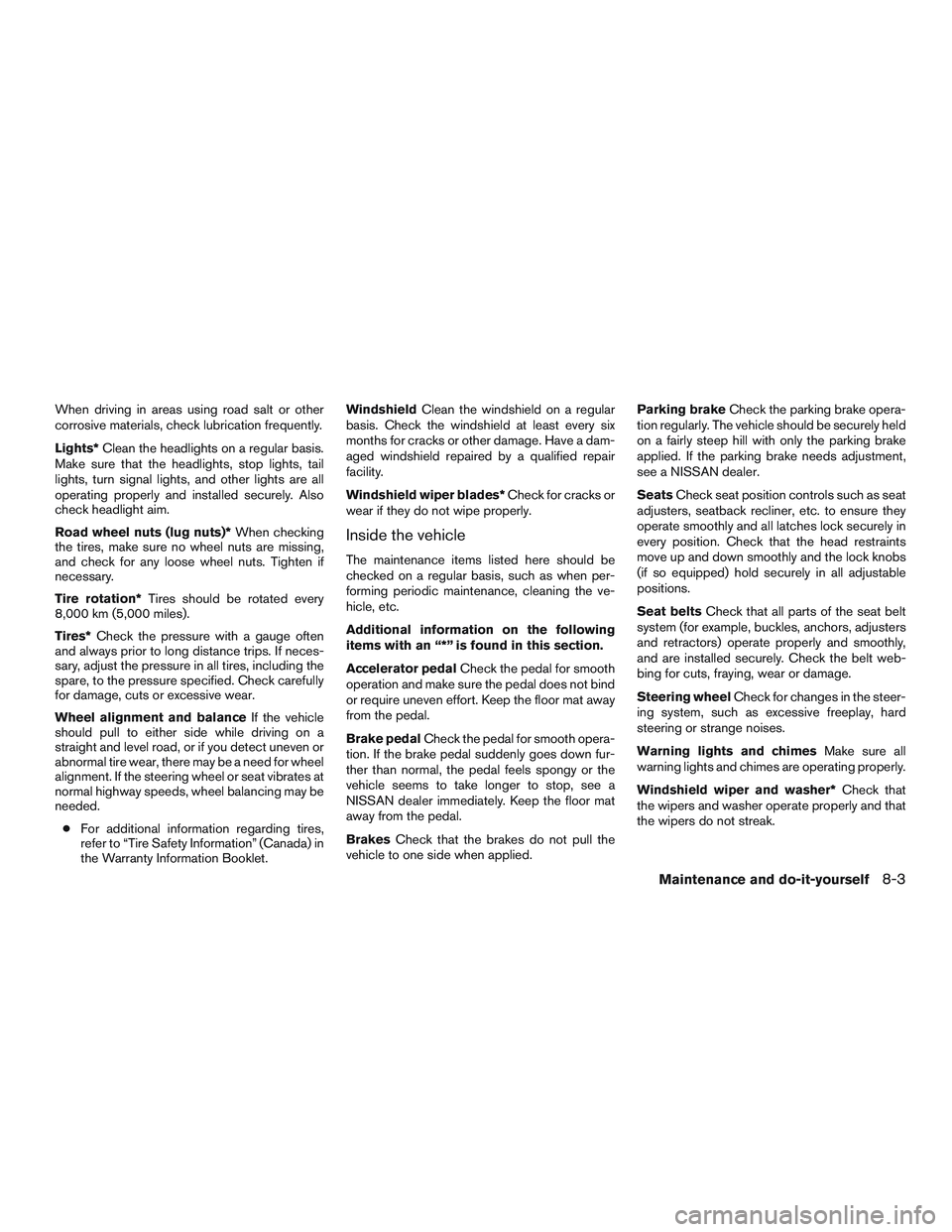
When driving in areas using road salt or other
corrosive materials, check lubrication frequently.
Lights*Clean the headlights on a regular basis.
Make sure that the headlights, stop lights, tail
lights, turn signal lights, and other lights are all
operating properly and installed securely. Also
check headlight aim.
Road wheel nuts (lug nuts)* When checking
the tires, make sure no wheel nuts are missing,
and check for any loose wheel nuts. Tighten if
necessary.
Tire rotation* Tires should be rotated every
8,000 km (5,000 miles).
Tires* Check the pressure with a gauge often
and always prior to long distance trips. If neces-
sary, adjust the pressure in all tires, including the
spare, to the pressure specified. Check carefully
for damage, cuts or excessive wear.
Wheel alignment and balance If the vehicle
should pull to either side while driving on a
straight and level road, or if you detect uneven or
abnormal tire wear, there may be a need for wheel
alignment. If the steering wheel or seat vibrates at
normal highway speeds, wheel balancing may be
needed.
● For additional information regarding tires,
refer to “Tire Safety Information” (Canada) in
the Warranty Information Booklet. Windshield
Clean the windshield on a regular
basis. Check the windshield at least every six
months for cracks or other damage. Have a dam-
aged windshield repaired by a qualified repair
facility.
Windshield wiper blades* Check for cracks or
wear if they do not wipe properly.
Inside the vehicle
The maintenance items listed here should be
checked on a regular basis, such as when per-
forming periodic maintenance, cleaning the ve-
hicle, etc.
Additional information on the following
items with an “*” is found in this section.
Accelerator pedal Check the pedal for smooth
operation and make sure the pedal does not bind
or require uneven effort. Keep the floor mat away
from the pedal.
Brake pedal Check the pedal for smooth opera-
tion. If the brake pedal suddenly goes down fur-
ther than normal, the pedal feels spongy or the
vehicle seems to take longer to stop, see a
NISSAN dealer immediately. Keep the floor mat
away from the pedal.
Brakes Check that the brakes do not pull the
vehicle to one side when applied. Parking brake
Check the parking brake opera-
tion regularly. The vehicle should be securely held
on a fairly steep hill with only the parking brake
applied. If the parking brake needs adjustment,
see a NISSAN dealer.
Seats Check seat position controls such as seat
adjusters, seatback recliner, etc. to ensure they
operate smoothly and all latches lock securely in
every position. Check that the head restraints
move up and down smoothly and the lock knobs
(if so equipped) hold securely in all adjustable
positions.
Seat belts Check that all parts of the seat belt
system (for example, buckles, anchors, adjusters
and retractors) operate properly and smoothly,
and are installed securely. Check the belt web-
bing for cuts, fraying, wear or damage.
Steering wheel Check for changes in the steer-
ing system, such as excessive freeplay, hard
steering or strange noises.
Warning lights and chimes Make sure all
warning lights and chimes are operating properly.
Windshield wiper and washer* Check that
the wipers and washer operate properly and that
the wipers do not streak.
Maintenance and do-it-yourself8-3
Page 248 of 299

Rear window wiper blade
Contact a NISSAN dealer if checking or replace-
ment is required.If the brakes do not operate properly, have the
brakes checked by a NISSAN dealer.Self-adjusting brakes
Your vehicle is equipped with self-adjusting
brakes.
The front disc-type brakes self-adjust every time
the brake pedal is applied. The rear drum-type
brakes self-adjust every time the parking brake is
applied.
WARNING
See a NISSAN dealer for a brake system
check if the brake pedal height does not
return to normal.
Brake pad wear indicators
The disc brake pads on your vehicle have audible
wear indicators. When a brake pad requires re-
placement, a high pitched scraping or screech-
ing sound will be heard when the vehicle is in
motion. The noise will be heard whether or not the
brake pedal is depressed. Have the brakes
checked as soon as possible if the wear indicator
sound is heard.
Under some driving or climate conditions, occa-
sional brake squeak, squeal or other noise may
be heard. Occasional brake noise during light tomoderate stops is normal and does not affect the
function or performance of the brake system.
Proper brake inspection intervals should
be followed.
For additional information regard-
ing brake inspections, refer to the appropriate
maintenance schedule information in the
“NISSAN Service and Maintenance Guide”.
BRAKES
Maintenance and do-it-yourself8-19
Page 292 of 299
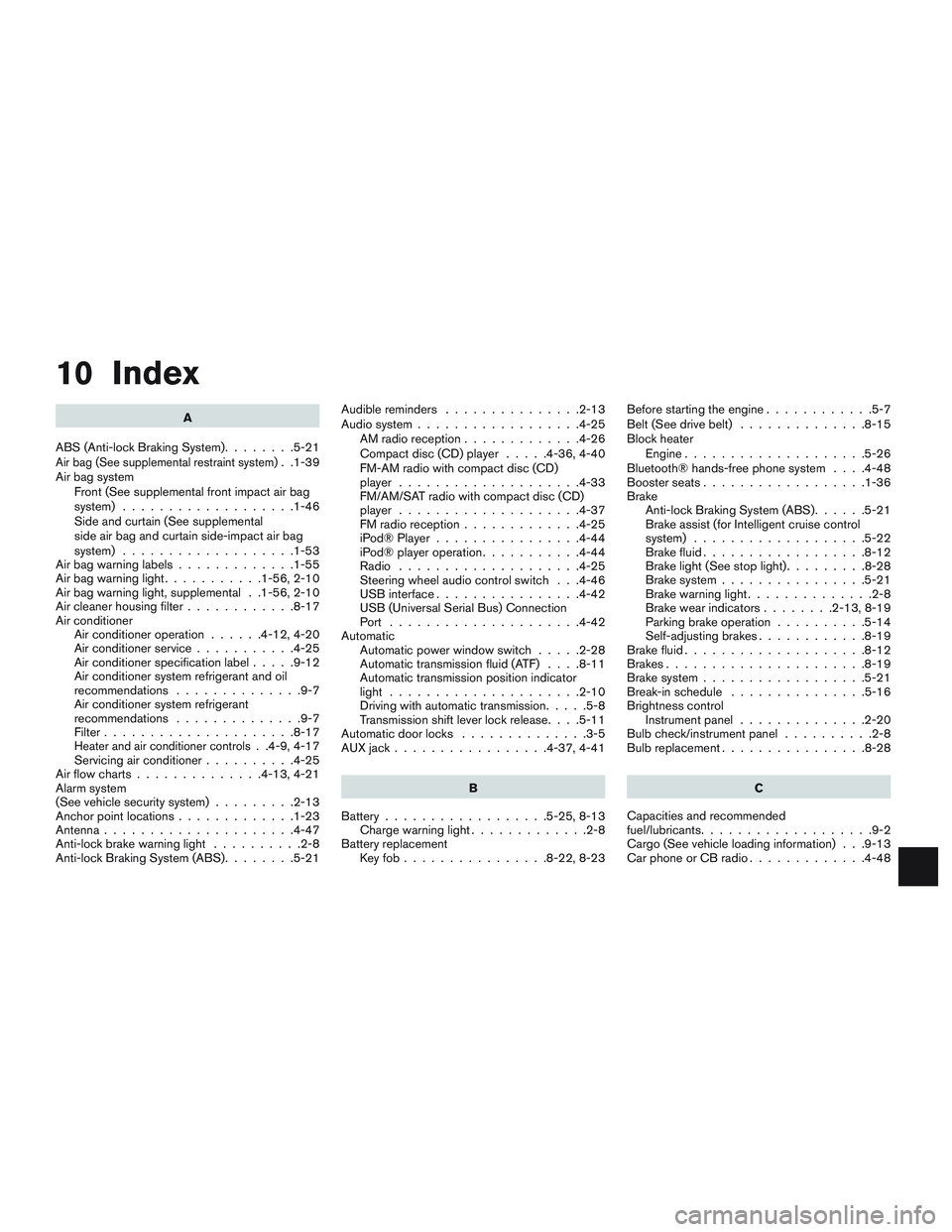
10 Index
A
ABS (Anti-lock Braking System) ........5-21
Air bag (See supplemental restraint system). .1-39
Air bag system Front (See supplemental front impact air bag
system) ...................1-46
Side and curtain (See supplemental
side air bag and curtain side-impact air bag
system) ...................1-53
Airbagwarninglabels.............1-55
Airbagwarninglight...........1-56,2-10
Air bag warning light, supplemental . .1-56, 2-10
Air cleaner housing filter ............8-17
Air conditioner Air conditioner operation ......4-12,4-20
Air conditioner service ...........4-25
Air conditioner specification label .....9-12
Air conditioner system refrigerant and oil
recommendations ..............9-7
Air conditioner system refrigerant
recommendations ..............9-7
Filter .....................8-17
Heater and air conditioner controls. .4-9, 4-17
Servicing air conditioner ..........4-25
Airflowcharts..............4-13,4-21
Alarm system
(See vehicle security system) .........2-13
Anchor point locations .............1-23
Antenna .....................4-47
Anti-lock brake warning light ..........2-8
Anti-lock Braking System (ABS) ........5-21Audible reminders
...............2-13
Audio system ..................4-25
AMradioreception.............4-26
Compact disc (CD) player .....4-36,4-40
FM-AM radio with compact disc (CD)
player ....................4-33
FM/AM/SAT radio with compact disc (CD)
player ....................4-37
FMradioreception.............4-25
iPod® Player ................4-44
iPod® player operation ...........4-44
Radio ....................4-25
Steering wheel audio control switch . . .4-46
USB interface ................4-42
USB (Universal Serial Bus) Connection
Port .....................4-42
Automatic Automatic power window switch .....2-28
Automatic transmission fluid (ATF) ....8-11
Automatic transmission position indicator
light .....................2-10
Driving with automatic transmission .....5-8
Transmission shift lever lock release ....5-11
Automatic door locks ..............3-5
AUXjack.................4-37,4-41
B
Battery ..................5-25,8-13
Chargewarninglight.............2-8
Battery replacement Keyfob................8-22,8-23 Before starting the engine
............5-7
Belt (See drive belt) ..............8-15
Block heater Engine ....................5-26
Bluetooth® hands-free phone system ....4-48
Boosterseats..................1-36
Brake Anti-lock Braking System (ABS) ......5-21
Brake assist (for Intelligent cruise control
system) ...................5-22
Brake fluid ..................8-12
Brakelight(Seestoplight).........8-28
Brake system ................5-21
Brakewarninglight..............2-8
Brakewearindicators........2-13,8-19
Parking brake operation ..........5-14
Self-adjusting brakes ............8-19
Brake fluid ....................8-12
Brakes ......................8-19
Brake system ..................5-21
Break-inschedule ...............5-16
Brightness control Instrument panel ..............2-20
Bulb check/instrument panel ..........2-8
Bulbreplacement................8-28
C
Capacities and recommended
fuel/lubricants ...................9-2
Cargo (See vehicle loading information) . . .9-13
Car phone or CB radio .............4-48
Page 296 of 299
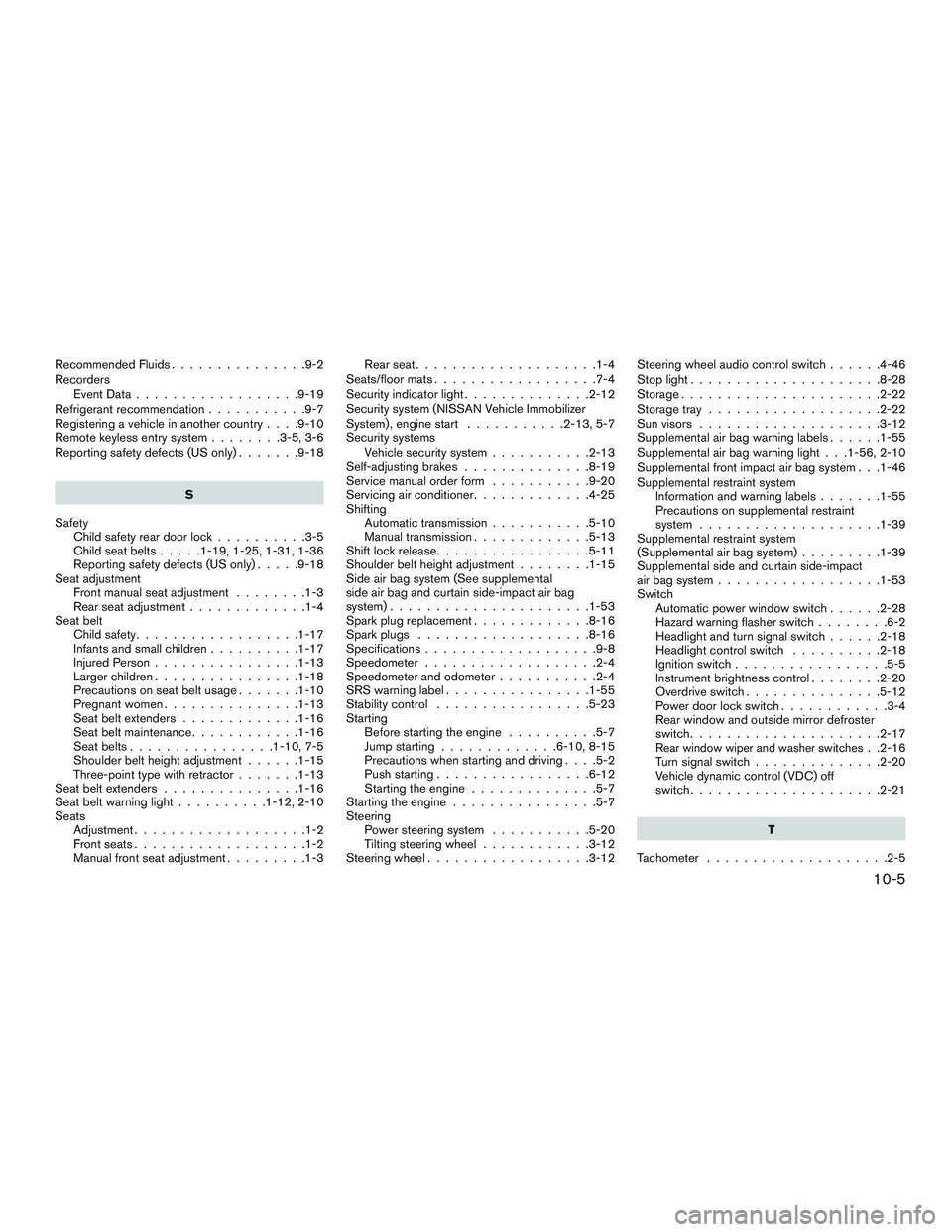
Recommended Fluids...............9-2
Recorders EventData..................9-19
Refrigerant recommendation ...........9-7
Registering a vehicle in another country ....9-10
Remote keyless entry system ........3-5,3-6
Reporting safety defects (US only) .......9-18
S
Safety Child safety rear door lock ..........3-5
Childseatbelts.....1-19,1-25,1-31,1-36
Reporting safety defects (US only) .....9-18
Seat adjustment Front manual seat adjustment ........1-3
Rear seat adjustment .............1-4
Seat belt Child safety ..................1-17
Infantsandsmallchildren..........1-17
InjuredPerson................1-13
Largerchildren................1-18
Precautionsonseatbeltusage.......1-10
Pregnant women ...............1-13
Seat belt extenders .............1-16
Seat belt maintenance ............1-16
Seat belts ................1-10,7-5
Shoulder belt height adjustment ......1-15
Three-point type with retractor .......1-13
Seat belt extenders ...............1-16
Seatbeltwarninglight..........1-12,2-10
Seats Adjustment ...................1-2
Frontseats...................1-2
Manual front seat adjustment .........1-3Rear seat
....................1-4
Seats/floor mats ..................7-4
Security indicator light ..............2-12
Security system (NISSAN Vehicle Immobilizer
System) , engine start ...........2-13,5-7
Security systems Vehicle security system ...........2-13
Self-adjusting brakes ..............8-19
Service manual order form ...........9-20
Servicing air conditioner .............4-25
Shifting Automatic transmission ...........5-10
Manual transmission .............5-13
Shift lock release .................5-11
Shoulder belt height adjustment ........1-15
Side air bag system (See supplemental
side air bag and curtain side-impact air bag
system) ......................1-53
Spark plug replacement .............8-16
Sparkplugs ...................8-16
Specifications ...................9-8
Speedometer ...................2-4
Speedometer and odometer ...........2-4
SRS warning label ................1-55
Stability control .................5-23
Starting Before starting the engine ..........5-7
Jump starting .............6-10,8-15
Precautions when starting and driving ....5-2
Push starting .................6-12
Starting the engine ..............5-7
Starting the engine ................5-7
Steering Power steering system ...........5-20
Tilting steering wheel ............
3-12
Steering wheel ..................3-12 Steeringwheelaudiocontrolswitch......4-46
Stoplight.....................8-28
Storage......................2-22
Storage tray
...................2-22
Sun visors ....................3-12
Supplemental air bag warning labels ......1-55
Supplemental air bag warning light . . .1-56, 2-10
Supplemental front impact air bag system . . .1-46
Supplemental restraint system Information and warning labels .......1-55
Precautions on supplemental restraint
system ....................1-39
Supplemental restraint system
(Supplemental air bag system) .........1-39
Supplemental side and curtain side-impact
air bag system ..................1-53
Switch Automatic power window switch ......2-28
Hazard warning flasher switch ........6-2
Headlightandturnsignalswitch......2-18
Headlight control switch ..........2-18
Ignition switch .................5-5
Instrument brightness control ........2-20
Overdrive switch ...............5-12
Powerdoorlockswitch............3-4
Rear window and outside mirror defroster
switch.....................2-17
Rear window wiper and washer switches. .2-16
Turnsignalswitch..............2-20
Vehicle dynamic control (VDC) off
switch.....................2-21
T
Tachometer ....................2-5
10-5